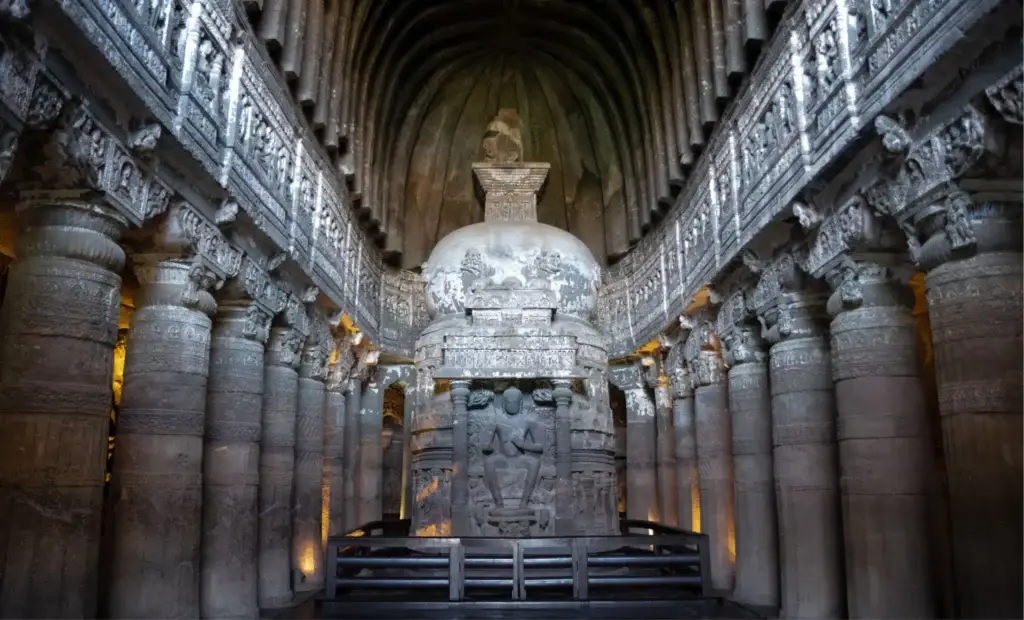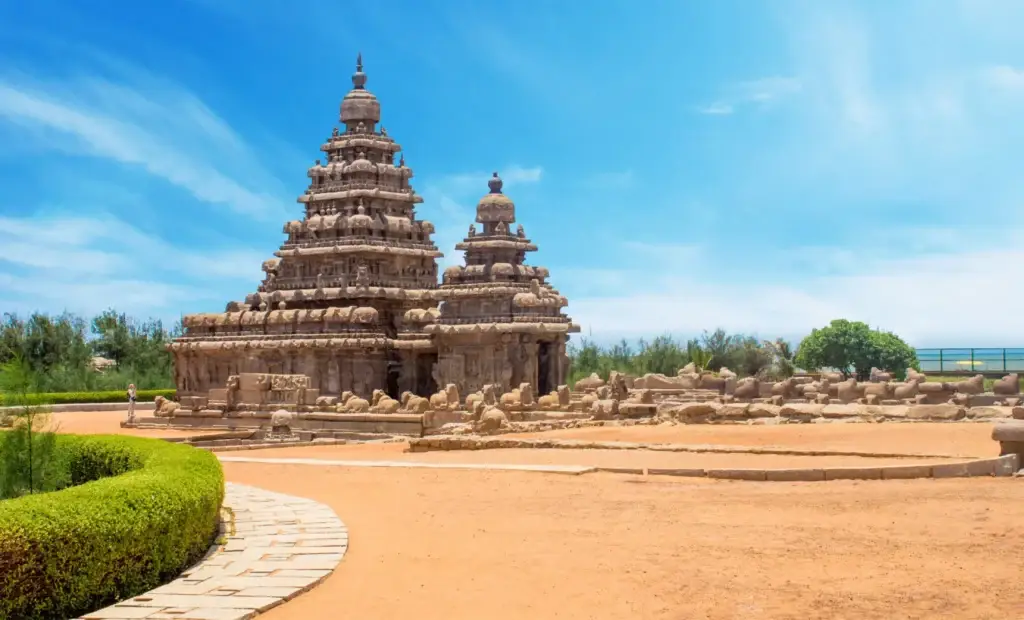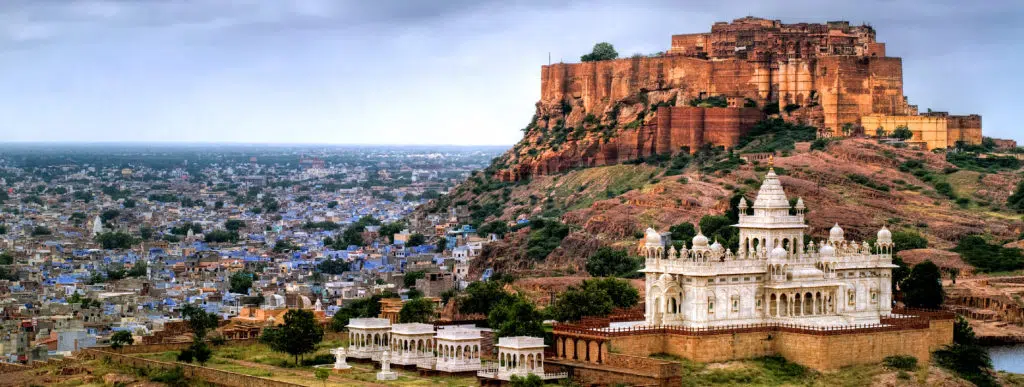Of the countless life-changing places to visit in India, so many date back to the early heights of civilization and serve as their own historical record of those eras. Carved into caves and upon the faces of immense stone are histories, legends, and exultations that connect us to the early cultures of this vast subcontinent.
We at Nomadic Expeditions invite you to explore the breadth of India with us and encounter such beautiful, transformational sites. Of the 40 UNESCO World Heritage sites in India, this list shares those dating from the beginning of civilization in the Indus Valley to the medieval era—marking the heights of empires and kingdoms lost to time.
Ajanta Caves
A unique artistic achievement, the caves at Ajanta are excavated out of a vertical cliff above the left bank of the river Waghora in the hills of Ajanta. They are thirty in number, including the unfinished ones, connected with the river by rock-cut staircases. The caves are decorated through expressive architectural forms of chaityagrihas and viharas as well as sculptures and painted panels depicting various Buddhist traditions. The earliest Buddhist cave monuments at Ajanta date from the 2nd and 1st centuries B.C. During the Gupta period (5th and 6th centuries A.D.), many more richly decorated caves were added to the original group. The paintings and sculptures of Ajanta, considered masterpieces of Buddhist religious art, have had a considerable artistic influence.

Ellora Caves
The Ellora Caves comprise 34 monasteries and temples, extending over more than 2 km. They were dug into a high basalt cliff not far from Aurangabad, in Maharashtra. Dating from around A.D. 600 to 1000 with a final phase in the 12th centuries, this complex of unique artistic creation and a technological exploit features sanctuaries devoted to Buddhism, Hinduism and Jainism—illustrative proof of the spirit of religious tolerance that was characteristic of ancient India. The largest temple is the Kailasa Temple and is elaborately decorated with sculptures and paintings.
Khajuraho Group of Monuments
Distributed over an area of 6 square km in a picturesque landscape, the temples at Khajuraho are rare surviving examples that display the originality and high quality of Nagara-style temple architecture. Built during the Chandella dynasty with its apogee between 950 and 1050, the temples are inspiring testaments. Only about 20 temples remain, representing two different religions – Hinduism and Jainism. They strike a perfect balance between architecture and sculpture. The Temple of Kandariya is decorated with a profusion of sculptures that are among the greatest masterpieces of Indian art. The composition and finesse achieved by the master craftsmen give the stone surfaces of the Khajuraho temples a rare vibrancy and sensitivity to the warmth of human emotions.
Group of Monuments at Pattadakal
Pattadakal, in Karnataka, represents the high point of an eclectic art which, in the 7th and 8th centuries under the Chalukya dynasty, achieved a harmonious blend of architectural forms from northern and southern India. An impressive series of nine Hindu temples, as well as a Jain sanctuary, can be seen there. One masterpiece from the group stands out – the Temple of Virupaksha, built c. 740 by Queen Lokamahadevi to commemorate her husband’s victory over the kings from the South.
Elephanta Caves
This “City of Caves” is on Elephanta Island in the Sea of Oman close to Bombay. It contains a collection of rock art linked to the cult of Shiva. Here, Indian art has found one of its most perfect expressions, particularly the huge high reliefs in the main cave. The small island is dotted with numerous ancient archaeological remains that are the sole testimonies to its rich cultural past—constructed via rock-cut in about the mid-5th to 6th centuries AD. The most important among the caves is the great Cave 1, which measures 39 metres from the front entrance to the back. The combination of aesthetic beauty and sculptural art throughout the caves reflects Hindu spiritualistic beliefs and symbology, which are finely utilized in the overall planning of the caves.
Buddhist Monuments at Sanchi
The stupas, temples, viharas, and stambha at Sanchi in central India are among the oldest and most mature examples of aniconic arts and free-standing architecture that comprehensively document the history of Buddhism from the 3rd century BC to the 12th century AD. Located on a hill overlooking a plain, the site of Sanchi comprises a group of Buddhist monuments, monolithic pillars, palaces, temples and monasteries—all in different states of conservation. The Buddhist monuments at Sanchi contain an appreciable concentration of early Indian artistic techniques and Buddhist art. The quality of craftsmanship in representing the gamut of symbolism through plants, animals, human beings, and Jataka stories shows the development of art though the integration of indigenous and non-indigenous sculpting traditions.
Mahabodhi Temple Complex at Bodh Gaya
The Mahabodhi Temple Complex is one of the four holy sites related to the life of the Lord Buddha, and particularly to the attainment of Enlightenment. The property encompasses the greatest remains of the 5th-6th century A.D in the Indian sub-continent belonging to this period of antiquity. The first temple was built by Emperor Asoka in the 3rd century B.C., and the present temple dates from the 5th or 6th centuries. It is one of the earliest Buddhist temples built entirely in brick, still standing in India, from the late Gupta period. In the context of philosophical and cultural history, Mahabodhi Temple Complex is of great relevance as it marks the most important event in the life of Lord Buddha, the moment when Prince Siddhartha attained Enlightenment and became Buddha, an event that shaped human thought and belief. This property is now revered as the holiest place of Buddhist pilgrimage in the world and is considered the cradle of Buddhism in the history of mankind.
Group of Monuments at Mahabalipuram – Tamil Nadu
Founded by the Pallava kings, this group of sanctuaries was carved out of rock along the Coromandel coast in the 7th and 8th centuries. It is known especially for its rathas (temples in the form of chariots), mandapas (cave sanctuaries), giant open-air reliefs such as the famous Descent of the Ganges, and the temple of Rivage, with thousands of sculptures to the glory of Shiva. The sculptural bas reliefs are a very important class of masterly creations created during Mamalla’s reign. There are four such reliefs at Mamallapuram, the most noteworthy among them being the Arjuna’s Penance and Govardhanadhari.

Hill Forts of Rajasthan
Within the State of Rajasthan, six extensive and majestic hill forts together reflect the elaborate, fortified seats of power of Rajput princely states that flourished between the 8th and 18th centuries and their relative political independence. The eclectic architecture of the forts, some up to 20 kilometers in circumference, bears testimony to the power of the Rajput princely states that flourished in the region. Enclosed within defensive walls are major urban centers, palaces, trading centers and other buildings including temples that often predate the fortifications. The forts use the natural defenses offered by the landscape: hills, deserts, rivers, and dense forests. They also feature extensive water harvesting structures, largely still in use today. Exemplary among these forts are the Amber Palace, representative of a key phase (17th century) in the development of a common Rajput-Mughal court style, and Jaisalmer, an example of a hill fort in desert terrain.
Rani-ki-Vav, the Queen’s Stepwell
On the banks of the Saraswati River, Rani-ki-Vav is an exceptional example of a distinctive form of subterranean water architecture on the Indian subcontinent. The stepwell was initially built as a memorial in the 11th century, constructed as a religious and functional structure designed as an inverted temple to celebrate the sanctity of water. Rani-ki-Vav is a single-component, water management system divided into seven levels of stairs and sculptural panels of high artistic and aesthetic quality. Within it, more than five hundred principle sculptures and over a thousand minor ones combine religious, mythological and secular imagery, often referencing literary works.
Archaeological Site of Nalanda Mahavihara
The Archaeological Site of Nalanda Mahavihara is located in the North-eastern state of Bihar, India. Dating from circa. 3 BC, it includes stupas, chaityas, viharas, shrines, many votive structures and important art works crafted in stucco, stone and metal. It comprises the archaeological remains of a monastic and scholastic institutions dating into the 13th century AD, as it was a site where knowledge flourished among monastic and educational traditions.
Dholavira, a Harappan City
The ancient city of Dholavira, the southern center of the Harappan Civilization, is sited on the arid island of Khadir in the State of Gujarat. Occupied between 3000-1500 BC, the archaeological site is one of the best preserved urban settlements from the period in Southeast Asia. Dholavira not only captures the entire trajectory of the rise and fall of this early civilization, but also demonstrates its multifaceted achievements in terms of urban planning, construction techniques, water management, social governance and development, art, manufacturing, trading, and belief system. The walled city consists of a fortified castle with attached fortified bailey and ceremonial ground, and a fortified middle town and a lower town. a series of reservoirs are found to the east and south of a citadel.

